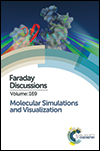A real-time proximity querying algorithm for haptic-based molecular docking†
Abstract
Intermolecular binding underlies every metabolic and regulatory processes of the cell, and the therapeutic and pharmacological properties of drugs. Molecular docking systems model and simulate these interactions in silico and allow us to study the binding process. Haptic-based docking provides an immersive virtual docking environment where the user can interact with and guide the molecules to their binding pose. Moreover, it allows human perception, intuition and knowledge to assist and accelerate the docking process, and reduces incorrect binding poses. Crucial for interactive docking is the real-time calculation of interaction forces. For smooth and accurate haptic exploration and manipulation, force-feedback cues have to be updated at a rate of 1 kHz. Hence, force calculations must be performed within 1ms. To achieve this, modern haptic-based docking approaches often utilize pre-computed force grids and linear interpolation. However, such grids are time-consuming to pre-compute (especially for large molecules), memory hungry, can induce rough force transitions at cell boundaries and cannot be applied to flexible docking. Here we propose an efficient proximity querying method for computing intermolecular forces in real time. Our motivation is the eventual development of a haptic-based docking solution that can model molecular flexibility. Uniquely in a haptics application we use octrees to decompose the 3D search space in order to identify the set of interacting atoms within a cut-off distance. Force calculations are then performed on this set in real time. The implementation constructs the trees dynamically, and computes the interaction forces of large molecular structures (i.e. consisting of thousands of atoms) within haptic refresh rates. We have implemented this method in an immersive, haptic-based, rigid-body, molecular docking application called Haptimol_RD. The user can use the haptic device to orientate the molecules in space, sense the interaction forces on the device, and guide the molecules to their binding pose. Haptimol_RD is designed to run on consumer level hardware, i.e. there is no need for specialized/proprietary hardware.
- This article is part of the themed collection: Molecular Simulations and Visualization

 Please wait while we load your content...
Please wait while we load your content...